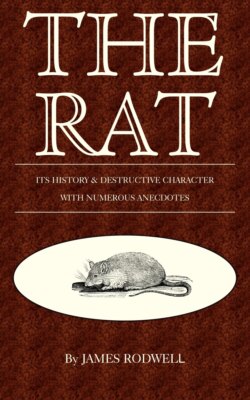Читать книгу The Rat; Its History & Destructive Character - James Rodwell - Страница 10
На сайте Литреса книга снята с продажи.
Albinos, or White Rats.
ОглавлениеBefore I give an account of the Brown rat, I must notice the Albino, or White rat. Some authors believe it is a mere accidental variation of the brown rat. Mr. Richardson, in his “Pests of the Farm,” also expresses the same opinion. He says, “The common brown rat sometimes presents albino characteristics; that is to say, it is occasionally to be found of a white colour, with red eyes. In the neighbourhood of Greenock, for instance, he says, there were, some years ago, numbers of these albinos to be met with, especially among the shipping. Some specimens were sent him, and he kept one of them as a pet for a considerable time.”
A colony of white rats was lately discovered in the Ainsworth Colliery, near Bury. They committed great depredations, when they had an opportunity, upon the food of the colliers.
In London, at the present time, these animals, being bred for fancy, are becoming very numerous, and sell at the rate of four shillings a couple. In shape and manners they are exactly like the common barn rat, but rather smaller. Their fur in every part is purest white; and their eyes, noses, and skin, beneath the fur, are of a most delicate pink.
The first who bred these for fancy and profit was a person by the name of Ostin, residing in the Waterloo Road; and he was the first man who brought to perfection the happy family, which may be seen daily at the foot of Waterloo Bridge, London. He informed me that he first procured two white rats, male and female, from Normandy about three years ago; and from this couple he has bred an immense number in cages. He has also initiated his son-in-law in the art of subduing the natural cravings of various animals, and reducing them to one standard of peace and equality. He exhibits his happy family every fine evening in Regent Street, and in the present instance is my principal informant. At the time I write he has above a hundred white rats, besides others. He has crossed the breed with the brown and black rat; and has produced a vast number of both brown and white, and black and white piebald young ones, which are pretty little creatures, and as tame as kittens. He says, “they breed six times in the year; and when the young are two weeks old, the mother is again pregnant. The young ones will breed at four months old.” He mentioned one female which bred so fast that she died from sheer exhaustion. But the natural powers of the rat for breeding are so great, that I believe few animals, if any, in the creation can equal them. He also informs me that these animals are subject to no diseases, except when kept in a dirty cage for any length of time; and then, like ferrets, they are subject to a kind of mange; but cleanliness and good diet will soon cure them. The most he has had in a litter were thirteen, and not a dark hair among them.
Now this does not favour the general opinion of naturalists, or of Mr. Richardson, as to the albino or white rat being an accidental variation from the brown or black rat, because it is a well-known fact to all breeders, either of beasts or birds, that any young one, which may accidentally vary in colour from the rest, will in breeding-time revert to the original stock. So far from doing this, the albino, or white rat, will breed for generations together without varying in colour. Consequently I am led to believe that they are a bonâ fide species; but this I will most humbly leave in the hands of profound naturalists to investigate and decide.
